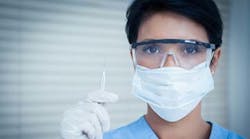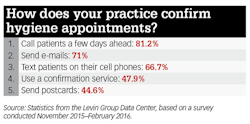Research report: The state of hygiene in today's practices
Dental hygiene is a key indicator of practice growth. A nearly full hygiene schedule not only contributes directly to practice production, but also leads to greater doctor production. A healthy hygiene department usually signifies a financially healthy practice.
In a recent survey conducted by the Levin Group Data Center, we asked dentists to tell us about the state of their hygiene departments. The responses we received lead us to be cautiously optimistic about dentists' ability to grow their practices in the current economic climate. We will know more upon the completion of our analysis of the larger and more comprehensive Dental Economics/Levin Group Annual Practice Survey, which closed on April 30. Look for our research report in the September issue of Dental Economics.
Increased hygiene production
For 41.7% of dentists who participated in our recent survey, monthly hygiene production increased during the last 12 months. In addition, 21.1% of participants said no-shows and cancellations for hygiene appointments had decreased in the past 12 months.
These are positive signs for a dental economy that has been slowly recovering from the aftermath of the Great Recession. The hygiene department drives production for other services. The fuller the hygiene schedule, the more productive the practice.
However, let's take a step back and look at the whole picture. More than 45% of participants said hygiene production remained the same, with 12.8% of dentists experiencing declines. This means 87% of responding practices are growing or maintaining their hygiene production. Coversely, in the years immediately following the Great Recession, a majority of general dentists saw their hygiene production (and the number of hygiene patients) decrease.
More than half of responding dentists (54.4%) said hygiene accounted for 30% of their total production, with nearly a quarter of doctors (24%) reporting that hygiene comprised more than 40% of practice production. Levin Group recommends that hygiene account for approximately 25% of all production. If a practice is above this mark, it usually indicates that the dentist isn't presenting enough treatment, especially multitooth and elective procedures.
READ MORE | 4 ways to ramp up hygiene production
Confirming hygiene appointments is necessary to prevent no-shows and cancellations. As technologies have evolved in the last decade, dentists have gotten more sophisticated in their approach to confirming appointments, with many using multiple methods to remind patients about their upcoming appointments.
While the telephone is still the number one confirmation method with 81.2% of practices using it, sending e-mails (71%) and texting patient cell phones (66.7%) are gaining in popularity. Nearly half of practices use a confirmation service (47.9%), while a smaller minority (44.6%) still sends postcards.
To reach a diverse patient base, practices have to be flexible in how they communicate with patients. Older patients may tend to prefer a postcard or a phone call. Younger patients may opt for a text or e-mail. Those are just examples. There are plenty of seniors who spend more time on their computers and cell phones than millennials. What it comes down to is that practices have to know their patients and give them multiple options on how they want to be contacted.
READ MORE | Are your systems failing you?
As to who schedules the next appointment in dental practices, the results were nearly a tie, with the hygienist edging the front desk, 63.4% to 62.3%. It should be noted that this question allowed respondents to provide more than one answer. In many practices, both employees perform the scheduling. Only 3.2% of dentists are doing hygiene scheduling. This should never happen unless it's an emergency situation when key employees are out that day.
Home care
Hygienists have a unique relationship with patients. On average, they spend more time with patients than anybody else in the practice, including the dentist. Two-thirds of practices (67.1%) had one or two full-time hygienists, with 34.3% of offices employing one part-time hygienist.
Based on the positive hygienist-patient relationship that occurs in most practices, it shouldn't come as a surprise that 92.8% of hygienists make home-care recommendations. Helping patients improve their oral health is the central mission of dentistry, and a responsibility that hygienists take very seriously.
Final thoughts
The hygiene appointment is the driver of practice production. According to our survey, more than 40% of responding dentists are increasing their hygiene production. How would you rate your practice's hygiene production? Are you maximizing the potential within your hygiene department? Do you have the right hygiene systems in place? If you don't, you could be limiting your practice's ability to grow in today's economy.
Systems training for dentists: Learn key systems for increasing hygiene efficiency, reducing stress, and gaining more patients at Dr. Levin's all-new seminar. To find out more, go to levingroup.com/gpseminars.
Roger P. Levin, DDS, is the founder and CEO of Levin Group Inc., a leading dental consulting firm. A nationally recongized speaker, Dr. Levin presents practice management seminars throughout the country.

